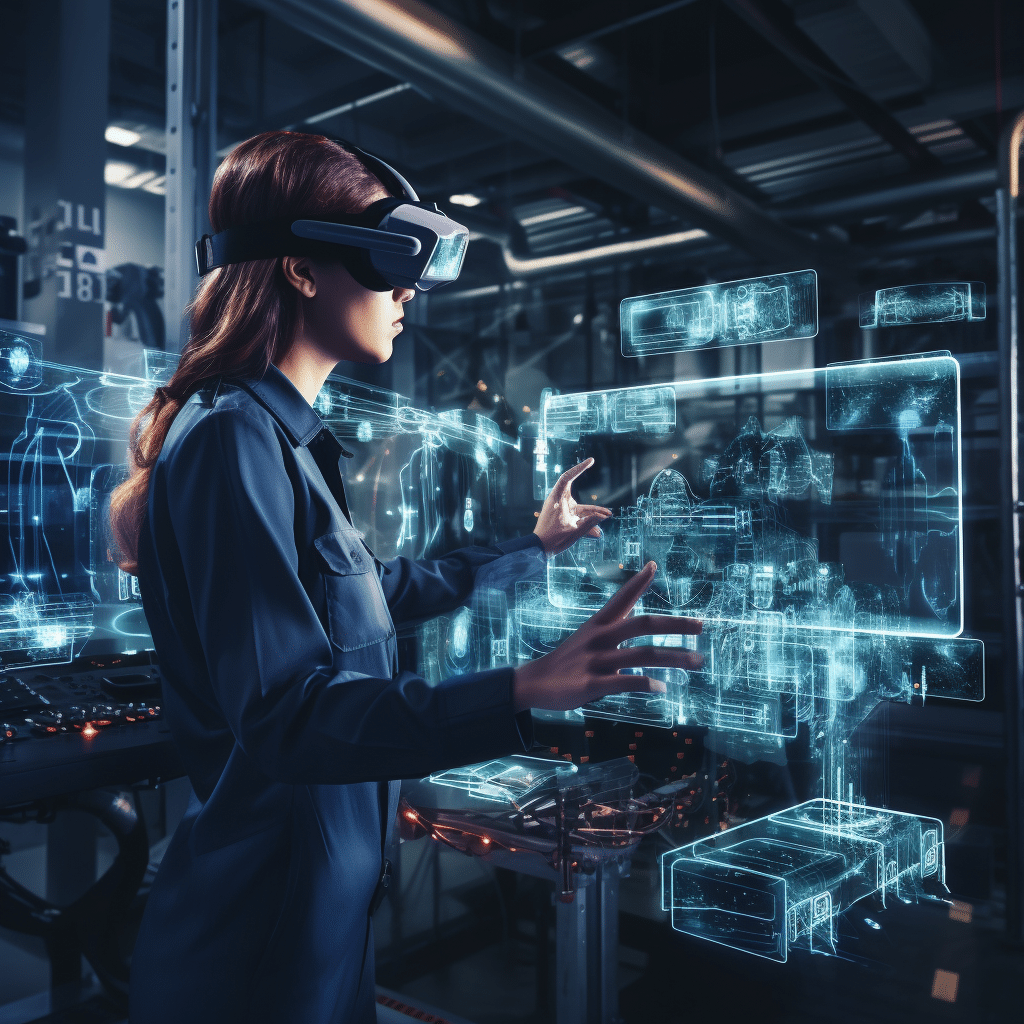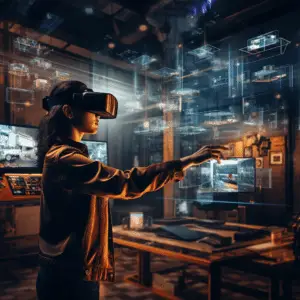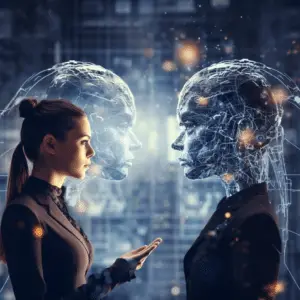
The Future of AI-Powered Virtual Reality and Augmented Reality
AI-Powered Virtual Reality and Augmented Reality, Over the last few years, we have witnessed astounding advancements in the realms of virtual reality (VR) and augmented reality (AR). From immersive gaming experiences to practical applications in healthcare and education, these technologies have already begun transforming various industries. However, the future of VR and AR lies at the intersection with another rapidly growing field: artificial intelligence (AI).
AI-powered VR and AR systems have the potential to unlock new frontiers, enhancing our lives in unimaginable ways. With AI algorithms powering these technologies, we can expect more realistic, dynamic, and personalized experiences, where virtual worlds seamlessly blend with the real.
The Rise of AI-Powered Virtual Reality

A key aspect of VR is creating a fully immersive and interactive digital environment. AI can significantly enhance this experience by enabling virtual worlds to adapt and respond intelligently to user input. Natural language processing and machine learning algorithms can understand and interpret user movements, gestures, and voice commands, making the VR experience more intuitive and lifelike.
AI can also enhance visual and auditory elements in VR, allowing for realistic rendering of objects, environments, and sounds. Deep learning algorithms can generate lifelike textures, lighting effects, and spatial audio, creating a more immersive and believable virtual world.
Transforming Augmented Reality with AI
AR, on the other hand, aims to overlay digital content onto the real world, blending the virtual and physical realms seamlessly. AI can play a vital role in improving the accuracy and coherence of these overlays.
By leveraging computer vision algorithms, AR devices can better understand and interpret the user’s surroundings. Object recognition, depth perception, and scene understanding capabilities can be significantly enhanced, resulting in more precise and contextually relevant virtual content overlaid on the real world. This opens up a myriad of possibilities in fields such as navigation, interior design, and industrial maintenance.
The Future Possibilities
Combining AI with VR and AR can revolutionize industries such as healthcare, education, and entertainment. In healthcare, surgeons can practice complex procedures in a realistic virtual environment, fostering improved surgical outcomes. Students can explore historically accurate virtual worlds, making history lessons more captivating and engaging.
Entertainment experiences will reach new heights as AI algorithms analyze user preferences to create personalized content and simulations. Storylines in video games can dynamically adapt to the player’s choices and behaviors, providing engaging and unique experiences tailored to each player.
Furthermore, AI-powered VR and AR can pave the way for augmented teleconferencing, allowing people to have more lifelike virtual meetings. It could potentially revolutionize remote work, collaboration, and social interactions by bridging the geographical gap.
In conclusion, combining AI with VR and AR enhances the capabilities of these already transformative technologies. The future of AI-powered VR and AR holds immense potential for innovation and improvement across various sectors, opening up a world of endless possibilities. As AI continues to evolve, we can expect even more seamless, realistic, and personalized experiences that will reshape the way we interact with and perceive the world around us.
How can AI-driven virtual reality and augmented reality contribute to enhanced user experiences and personalized interactions in the future
AI-driven virtual reality and augmented reality (AR/VR) have the potential to greatly enhance user experiences and deliver personalized interactions in the future. Here are some ways in which they can contribute:
1. Enhanced Immersion
AI can analyze user preferences, behaviors, and real-time data to create more immersive and realistic virtual reality experiences. By understanding the user’s interests and adapting the virtual environment accordingly, AI can provide personalized content and interactions, making the experience more engaging and enjoyable.
2. Real-time Adaptation
AI algorithms can continuously analyze user inputs, body language, and facial expressions in AR/VR environments. This enables virtual characters or elements to respond in real-time to the user’s actions and emotions, creating a more dynamic and interactive experience. For example, virtual characters can adjust their behavior or dialogue based on user preferences or emotional cues.
3. Personalized Content
AI algorithms can use data collected from user interactions and preferences to deliver personalized content in AR/VR. By understanding the user’s interests, AI can recommend relevant virtual objects, environments, or experiences that align with their preferences and offer a more tailored experience.
4. Natural Language Processing
AI-powered natural language processing can enable more natural and seamless interactions in AR/VR. Users can communicate with virtual characters or objects using voice commands, and AI algorithms can interpret and respond to these commands. This can create a more intuitive and user-friendly experience, allowing users to have natural conversations and interactions within virtual environments.
5. Adaptive Learning
AI can employ machine learning techniques to analyze user behavior and preferences in AR/VR. By continuously learning from user interactions, AI algorithms can adapt and personalize the experience over time. This means that the more a user interacts with AR/VR, the more tailored and customized their experience becomes.
6. Remote Collaboration and Communication
AI-driven AR/VR can enable remote collaboration by simulating face-to-face interactions. Users can interact with virtual avatars of their colleagues or clients, allowing for a more immersive and realistic collaboration experience, regardless of geographical distance. AI can also translate and interpret languages in real-time, improving communication for global teams.
Overall, AI-driven virtual reality and augmented reality offer immense potential to enhance user experiences and provide personalized interactions. By leveraging AI’s capabilities for analysis, adaptation, personalization, and natural language processing, AR/VR can become more immersive, intuitive, and tailored to individual users.
How will AI impact the development and advancement of virtual reality and augmented reality technologies?
AI is expected to have a significant impact on the development and advancement of virtual reality (VR) and augmented reality (AR) technologies. Here are a few ways AI will influence these technologies:
1. Improved User Experience
AI can enhance the user experience in both VR and AR by analyzing user behavior, preferences, and physiological data in real-time. This enables AI systems to personalize the content and adapt the VR/AR environment accordingly. For example, AI can adjust the lighting, sound, or visuals to optimize the user experience based on individual preferences or physiological responses.
2. Realistic Interactions
AI can improve the realism of interactions within VR and AR. Machine learning algorithms can be used to analyze and understand human movements and gestures, enabling more natural and immersive interactions. This can make virtual objects or characters respond more realistically to users’ actions, enhancing the overall sense of presence within the virtual environment.
3. Content Generation
AI can automate and optimize the generation of VR and AR content. For instance, AI algorithms can create realistic 3D models, textures, and environments, which reduces the time and effort required for manual content creation. AI can also generate dynamic and interactive scenarios by analyzing real-world data and simulation models.
4. Cognitive Assistance
AI can provide cognitive assistance in VR and AR applications. By combining AI capabilities with computer vision, natural language processing, and machine learning, virtual or augmented environments can understand and respond to user queries, provide contextual information, and offer guidance or support. This can be particularly useful for training, education, or complex tasks.
5. Data Analysis and Insights
AI can analyze the enormous amounts of data generated by VR and AR systems, helping to extract valuable insights. For example, AI algorithms can analyze user behavior patterns, preferences, or physiological responses to optimize the design, functionality, or content of VR/AR applications. Such insights can also be used to improve user safety, enhance performance, or personalize the experience further.
Overall, AI’s integration into VR and AR technologies holds immense potential to transform and improve these immersive experiences, making them more realistic, personalized, and interactive.
What potential benefits can AI-powered virtual reality and augmented reality offer to various industries and sectors in the future?

AI-powered virtual reality and augmented reality offer numerous potential benefits to various industries and sectors in the future. Some of these benefits include:
1. Enhanced Training and Education
AI-powered virtual reality and augmented reality can provide highly realistic and immersive training experiences. This can be particularly useful in industries such as healthcare, aviation, manufacturing, and military, where hands-on training is crucial.
2. Improved Product Design and Visualization
By integrating AI with virtual reality and augmented reality, designers can create realistic prototypes and visualize products before they are actually built. This can save time and resources, and allow for better design iterations.
3. Enhanced Customer Experience
AI-powered virtual reality and augmented reality can be used to create personalized and immersive experiences for customers. For example, in retail, customers can virtually try on clothes or test products before making a purchase.
4. Remote Collaboration and Communication
AI-powered virtual reality and augmented reality can enable remote teams to collaborate effectively, even if they are located in different parts of the world. This can improve communication, problem-solving, and decision-making processes.
5. Real-time Data Visualization
By integrating AI and augmented reality, industries such as logistics and warehousing can visualize real-time data and make better decisions. For example, warehouse managers can use augmented reality glasses to see inventory levels, track shipments, and optimize storage space.
6. Enhanced Medical Diagnosis and Treatment
AI-powered virtual reality and augmented reality can aid in medical diagnosis by providing doctors with real-time data visualization and simulations. Surgeons can also use augmented reality to overlay digital information onto a patient’s body during surgery, enhancing precision and efficiency.
7. Enhanced Entertainment and Gaming
AI-powered virtual reality and augmented reality can revolutionize the entertainment and gaming industries by providing more immersive and interactive experiences. Users can interact with virtual characters, environments, and objects in a more realistic and engaging manner.
Overall, the integration of AI with virtual reality and augmented reality has the potential to transform various industries and sectors by improving training, visualization, collaboration, decision-making, and customer experiences.









hello there and thank you for your info – I have certainly
picked up something new from right here. I did however expertise several technical issues using this website, since I experienced to reload the site many
times previous to I could get it to load properly.
I had been wondering if your hosting is
OK? Not that I am complaining, but sluggish loading instances
times will very frequently affect your placement in google
and can damage your high quality score if advertising and marketing with Adwords.
Well I am adding this RSS to my e-mail and could look out for a lot more of your respective intriguing content.
Ensure that you update this again soon.. Lista
escape roomów
Very interesting topic, appreciate it for putting up.?